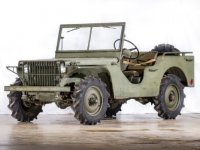BLReed
Sergeant Major
- Joined
- Nov 22, 2009
- Messages
- 1,676

http://www.armytimes.com/story/military/tech/2015/12/13/oldest-army-jeep-finally-gets-some-tlc/77245868/
Video:
https://www.youtube.com/watch?v=HIBfU2lSfkY&feature=youtu.be
The government didn't really know what it wanted," when jeep development began, Fiat Chrysler historian Brandt Rosenbuch said. The Army began work on specifications for a light four-wheel-drive reconnaissance vehicle in 1937 with American Bantam of Butler, Penn.
"Bantam deserves the vast majority of the credit for developing the basic concept and capabilities that became the Jeep," Gessler said.
Henry Ford was a staunch pacifist with little interest in the war brewing overseas, but he thought a little four-wheel-drive vehicle could be useful for agriculture, one of his passions. His more globally minded son Edsel used that opening to spearhead the GP-No.1 project, beginning a process that would see Ford become a vital supplier of wartime equipment.
"It's an icon of World War II and a symbol of wartime production by the auto industry," said Matt Anderson, transportation curator at the Henry Ford Museum in Dearborn. "It's also the grandfather of all SUVs. It's very rare to be able to trace a whole class of vehicles to a single one, but this is where it all began."
Willys built 362,894 wartime Jeeps, all at its headquarters plant in Toledo, Ohio. Ford built 285,660, initially at the Rouge plant in Detroit that today produces F-150 pickups. Ford later added Jeep production in several other plants around the country, including Louisville, Kentucky, where it still builds pickups and SUVs.
American Bantam got the short end of the stick, building just 2,676 Jeeps. The Army threw the little company a bone with a contract to build the trailers that hauled equipment behind Jeeps.
When soldiers from Headquarters Company, 15th Infantry
When soldiers from Headquarters Company, 15th Infantry come to a bad spot with their "Blitz Buggies," they just picked them up and move them. The Jeep was the latest in battlefield equipment early in World War II. (Photo: Army)
The Jeep remained in military service for decades, but it was popular with civilians before the guns of World War II even fell silent. Willys got special permission to begin building civilian Jeeps months before other automakers were allowed to switch from wartime production and resume their usual businesses.
"It was initially marketed as a farm vehicle," Rosenbuch said. "That's why the government allowed civilian production, to help get the economy up and running after the war."
Henry Ford donated GP-No.1 to the museum that bears his name in Dearborn in 1948. It remained there, getting surprisingly little attention, until the museum sold it and some other "minor" items from its collection in 1982.
History buff Randy Withrow of Huntsville snapped it up.
"It gave me a chill," he said. "I couldn't believe they'd auction it off.
Specifications of 1940 Ford "Pygmy" prototype GP-No.1
Vehicle type: Quarter-ton four-wheel-drive reconnaissance truck
Curb weight: Approximately 2,150 pounds
42 horsepower Ford 119.5 cubic-inch four-cylinder modified tractor engine
Spicer transfer case and axles
Suspension: beam axles on leaf springs
Length: 133 inches
Width: 59 inches
Height: 59 inches

